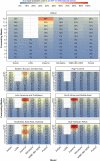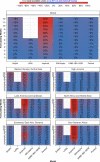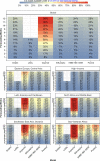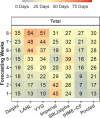This is a preprint.
Predictive performance of international COVID-19 mortality forecasting models
- PMID: 33236023
- PMCID: PMC7685335
- DOI: 10.1101/2020.07.13.20151233
Predictive performance of international COVID-19 mortality forecasting models
Update in
-
Predictive performance of international COVID-19 mortality forecasting models.Nat Commun. 2021 May 10;12(1):2609. doi: 10.1038/s41467-021-22457-w. Nat Commun. 2021. PMID: 33972512 Free PMC article.
Abstract
Forecasts and alternative scenarios of COVID-19 mortality have been critical inputs into a range of policies and decision-makers need information about predictive performance. We identified n=386 public COVID-19 forecasting models and included n=8 that were global in scope and provided public, date-versioned forecasts. For each, we examined the median absolute percent error (MAPE) compared to subsequently observed mortality trends, stratified by weeks of extrapolation, world region, and month of model estimation. Models were also assessed for ability to predict the timing of peak daily mortality. The MAPE among models released in July rose from 1.8% at one week of extrapolation to 24.6% at twelve weeks. The MAPE at six weeks were the highest in Sub-Saharan Africa (34.8%), and the lowest in high-income countries (6.3%). At the global level, several models had about 10% MAPE at six weeks, showing surprisingly good performance despite the complexities of modelling human behavioural responses and government interventions. The framework and publicly available codebase presented here ( https://github.com/pyliu47/covidcompare ) can be routinely used to compare predictions and evaluate predictive performance in an ongoing fashion.
Conflict of interest statement
Competing Interests
The authors declare they have no competing interests as defined by Nature Research that might be perceived to influence the results and/or discussion reported in this manuscript.
Figures







References
-
- Team IC-19 health service utilization forecasting, Murray CJ. Forecasting COVID-19 impact on hospital bed-days, ICU-days, ventilator-days and deaths by US state in the next 4 months. medRxiv 2020; : 2020.03.27.20043752.
-
- Weinberger D, Cohen T, Crawford F, et al. Estimating the early death toll of COVID-19 in the United States. medRxiv 2020; : 2020.04.15.20066431.
-
- Epidemic Model Guided Machine Learning for COVID-19 Forecasts in the United States | medRxiv. https://www.medrxiv.org/content/10.1101/2020.05.24.20111989v1 (accessed June 23, 2020). - DOI
-
- Critical Supply Shortages — The Need for Ventilators and Personal Protective Equipment during the Covid-19 Pandemic | NEJM. New England Journal of Medicine http://www.nejm.org/doi/full/10.1056/NEJMp2006141 (accessed July 26, 2020). - DOI - PubMed
Publication types
Grants and funding
LinkOut - more resources
Full Text Sources
